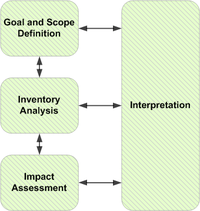
Photo from wikipedia
Abstract Due to economic, environmental, and other wider social issues, implementing sustainable urban drainage systems in developing countries is particularly complex. This study aimed to assess the adoption of low… Click to show full abstract
Abstract Due to economic, environmental, and other wider social issues, implementing sustainable urban drainage systems in developing countries is particularly complex. This study aimed to assess the adoption of low impact development (LID) strategies for a low-income settlement in Sao Carlos, Brazil, with the additional challenges presented by high-density, small lots, and social-economic constraints. A life cycle cost (LCC) analysis was conducted along with hydrological modeling for three scenarios. The business-as-usual (BAU) scenario: typical urban design and conventional drainage system (CDS). The infiltration well (IW) scenario: typical urban design and CDS associated with lots disconnection with IWs. The LID scenario: infiltration devices (swales and swale-trenches) associated with urban changes to achieve 100 % of runoff source control. A sensitivity analysis was carried out considering variations in the maintenance routine. The LCC revealed that the IW scenario had the higher overall costs: 15 % higher than BAU, and 5–22 % than LID. However, when the scenarios were assessed using a performance-based unit (costs/locally managed stormwater volume), the perspective changed: the LID scenario costs were the lowest (271–507 USD/m³), and BAU were the highest (926–1487 USD/m³). This joint assessment is expected to better assist the decision-making processes for sustainable stormwater management, balancing flood protection and costs.
Journal Title: Sustainable Cities and Society
Year Published: 2020
Link to full text (if available)
Share on Social Media: Sign Up to like & get
recommendations!